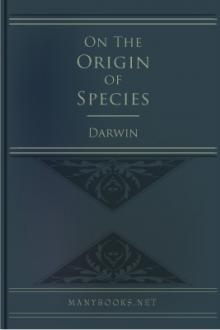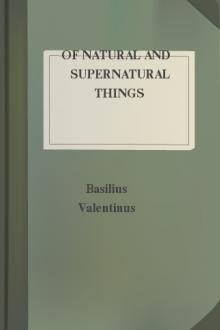The Origin of Species by means of Natural Selection (6th ed), Charles Darwin [the beginning after the end read novel .TXT] 📗

- Author: Charles Darwin
- Performer: -
Book online «The Origin of Species by means of Natural Selection (6th ed), Charles Darwin [the beginning after the end read novel .TXT] 📗». Author Charles Darwin
CELL-MAKING INSTINCT OF THE HIVEBEE.
I will not here enter on minute details on this subject, but will merely give an outline of the conclusions at which I have arrived. He must be a dull man who can examine the exquisite structure of a comb, so beautifully adapted to its end, without enthusiastic admiration. We hear from mathematicians that bees have practically solved a recondite problem, and have made their cells of the proper shape to hold the greatest possible amount of honey, with the least possible consumption of precious wax in their construction. It has been remarked that a skilful workman, with fitting tools and measures, would find it very difficult to make cells of wax of the true form, though this is effected by a crowd of bees working in a dark hive. Granting whatever instincts you please, it seems at first quite inconceivable how they can make all the necessary angles and planes, or even perceive when they are correctly made. But the difficulty is not nearly so great as at first appears: all this beautiful work can be shown, I think, to follow from a few simple instincts.
I was led to investigate this subject by Mr. Waterhouse, who has shown that the form of the cell stands in close relation to the presence of adjoining cells; and the following view may, perhaps, be considered only as a modification of his theory. Let us look to the great principle of gradation, and see whether Nature does not reveal to us her method of work.
At one end of a short series we have humble-bees, which use their old cocoons to hold honey, sometimes adding to them short tubes of wax, and likewise making separate and very irregular rounded cells of wax. At the other end of the series we have the cells of the hivebee, placed in a double layer: each cell, as is well known, is an hexagonal prism, with the basal edges of its six sides bevelled so as to join an inverted pyramid, of three rhombs. These rhombs have certain angles, and the three which form the pyramidal base of a single cell on one side of the comb, enter into the composition of the bases of three adjoining cells on the opposite side. In the series between the extreme perfection of the cells of the hivebee and the simplicity of those of the humble-bee, we have the cells of the Mexican Melipona domestica, carefully described and figured by Pierre Huber. The Melipona itself is intermediate in structure between the hive and humble bee, but more nearly related to the latter: it forms a nearly regular waxen comb of cylindrical cells, in which the young are hatched, and, in addition, some large cells of wax for holding honey. These latter cells are nearly spherical and of nearly equal sizes, and are aggregated into an irregular mass. But the important point to notice is, that these cells are always made at that degree of nearness to each other that they would have intersected or broken into each other if the spheres had been completed; but this is never permitted, the bees building perfectly flat walls of wax between the spheres which thus tend to intersect. Hence, each cell consists of an outer spherical portion, and of two, three, or more flat surfaces, according as the cell adjoins two, three or more other cells.
When one cell rests on three other cells, which, from the spheres being nearly of the same size, is very frequently and necessarily the case, the three flat surfaces are united into a pyramid; and this pyramid, as Huber has remarked, is manifestly a gross imitation of the three-sided pyramidal base of the cell of the hivebee. As in the cells of the hivebee, so here, the three plane surfaces in any one cell necessarily enter into the construction of three adjoining cells. It is obvious that the Melipona saves wax, and what is more important, labour, by this manner of building; for the flat walls between the adjoining cells are not double, but are of the same thickness as the outer spherical portions, and yet each flat portion forms a part of two cells.
Reflecting on this case, it occurred to me that if the Melipona had made its spheres at some given distance from each other, and had made them of equal sizes and had arranged them symmetrically in a double layer, the resulting structure would have been as perfect as the comb of the hivebee.
Accordingly I wrote to Professor Miller, of Cambridge, and this geometer has kindly read over the following statement, drawn up from his information, and tells me that it is strictly correct:-
If a number of equal spheres be described with their centres placed in two parallel layers; with the centre of each sphere at the distance of radius x sqrt(2) or radius x 1.41421 (or at some lesser distance), from the centres of the six surrounding spheres in the same layer; and at the same distance from the centres of the adjoining spheres in the other and parallel layer; then, if planes of intersection between the several spheres in both layers be formed, there will result a double layer of hexagonal prisms united together by pyramidal bases formed of three rhombs; and the rhombs and the sides of the hexagonal prisms will have every angle identically the same with the best measurements which have been made of the cells of the hivebee. But I hear from Professor Wyman, who has made numerous careful measurements, that the accuracy of the workmanship of the bee has been greatly exaggerated; so much so, that whatever the typical form of the cell may be, it is rarely, if ever, realised.
Hence we may safely conclude that, if we could slightly modify the instincts already possessed by the Melipona, and in themselves not very wonderful, this bee would make a structure as wonderfully perfect as that of the hivebee. We must suppose the Melipona to have the power of forming her cells truly spherical, and of equal sizes; and this would not be very surprising, seeing that she already does so to a certain extent, and seeing what perfectly cylindrical burrows many insects make in wood, apparently by turning round on a fixed point. We must suppose the Melipona to arrange her cells in level layers, as she already does her cylindrical cells; and we must further suppose, and this is the greatest difficulty, that she can somehow judge accurately at what distance to stand from her fellow-labourers when several are making their spheres; but she is already so far enabled to judge of distance, that she always describes her spheres so as to intersect to a certain extent; and then she unites the points of intersection by perfectly flat surfaces. By such modifications of instincts which in themselves are not very wonderful—hardly more wonderful than those which guide a bird to make its nest—I believe that the hivebee has acquired, through natural selection, her inimitable architectural powers.
But this theory can be tested by experiment. Following the example of Mr.
Tegetmeier, I separated two combs, and put between them a long, thick, rectangular strip of wax: the bees instantly began to excavate minute circular pits in it; and as they deepened these little pits, they made them wider and wider until they were converted into shallow basins, appearing to the eye perfectly true or parts of a sphere, and of about the diameter of a cell. It was most interesting to observe that, wherever several bees had begun to excavate these basins near together, they had begun their work at such a distance from each other that by the time the basins had acquired the above stated width (i.e. about the width of an ordinary cell), and were in depth about one sixth of the diameter of the sphere of which they formed a part, the rims of the basins intersected or broke into each other. As soon as this occurred, the bees ceased to excavate, and began to build up flat walls of wax on the lines of intersection between the basins, so that each hexagonal prism was built upon the scalloped edge of a smooth basin, instead of on the straight edges of a three-sided pyramid as in the case of ordinary cells.
I then put into the hive, instead of a thick, rectangular piece of wax, a thin and narrow, knife-edged ridge, coloured with vermilion. The bees instantly began on both sides to excavate little basins near to each other, in the same way as before; but the ridge of wax was so thin, that the bottoms of the basins, if they had been excavated to the same depth as in the former experiment, would have broken into each other from the opposite sides. The bees, however, did not suffer this to happen, and they stopped their excavations in due time; so that the basins, as soon as they had been a little deepened, came to have flat bases; and these flat bases, formed by thin little plates of the vermilion wax left ungnawed, were situated, as far as the eye could judge, exactly along the planes of imaginary intersection between the basins on the opposite side of the ridge of wax.
In some parts, only small portions, in other parts, large portions of a rhombic plate were thus left between the opposed basins, but the work, from the unnatural state of things, had not been neatly performed. The bees must have worked at very nearly the same rate in circularly gnawing away and deepening the basins on both sides of the ridge of vermilion wax, in order to have thus succeeded in leaving flat plates between the basins, by stopping work at the planes of intersection.
Considering how flexible thin wax is, I do not see that there is any difficulty in the bees, whilst at work on the two sides of a strip of wax, perceiving when they have gnawed the wax away to the proper thinness, and then stopping their work. In ordinary combs it has appeared to me that the bees do not always succeed in working at exactly the same rate from the opposite sides; for I have noticed half-completed rhombs at the base of a just-commenced cell, which were slightly concave on one side, where I suppose that the bees had excavated too quickly, and convex on the opposed side where the bees had worked less quickly. In one well-marked instance, I put the comb back into the hive, and allowed the bees to go on working for a short time, and again examined the cell, and I found that the rhombic plate had been completed, and had become PERFECTLY FLAT: it was absolutely impossible, from the extreme thinness of the little plate, that they could have effected this by gnawing away the convex side; and I suspect that the bees in such cases stand in the opposed cells and push and bend the ductile and warm wax (which as I have tried is easily done) into its proper intermediate plane, and thus flatten it.
>From the experiment of the ridge of vermilion wax we can see that, if the bees were to build for themselves a thin wall of wax, they could make their cells of the proper shape, by standing at the proper distance from each other, by excavating at





Comments (0)